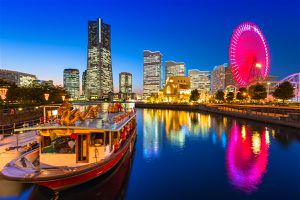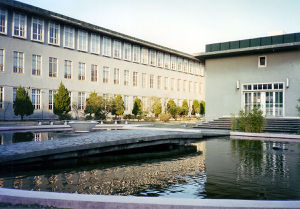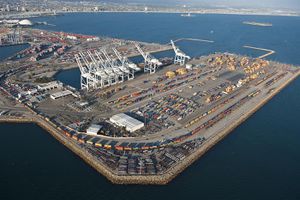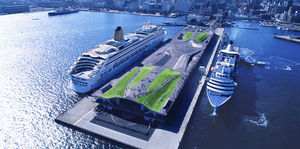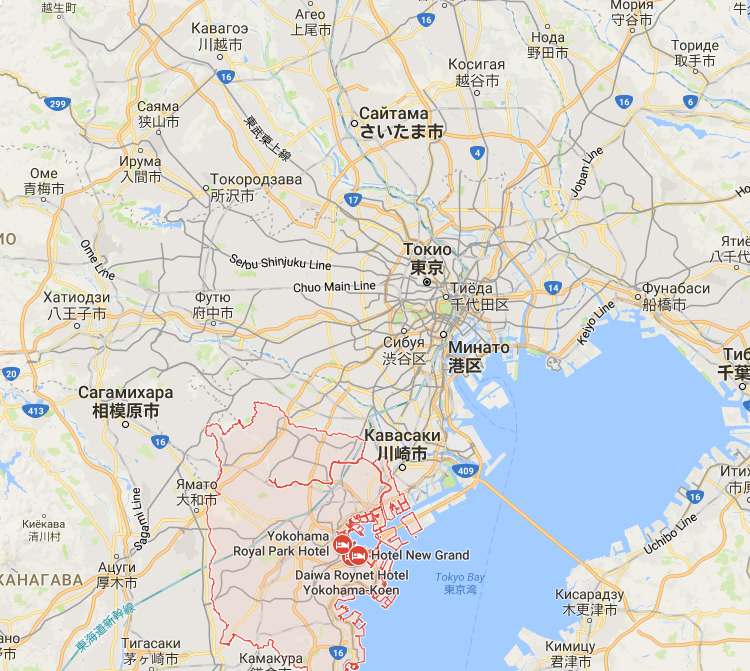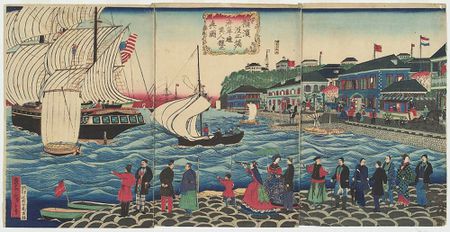Стаття до проекту "Моє рідне місто/село" Буткевича Антон Володимировича
Yokohama
Yokohama (横浜) is Japan's second largest city with a population of over three million. Yokohama is located less than half an hour south of Tokyo by train, and is the capital of Kanagawa Prefecture.
Towards the end of the Edo Period (1603-1867), during which Japan maintained a policy of self-isolation, Yokohama's port was one of the first to be opened to foreign trade in 1859. Consequently, Yokohama quickly grew from a small fishing village into one of Japan's major cities.
Until today, Yokohama remains popular among expats, has one of the world's largest chinatowns and preserves some former Western residences in the Yamate district.
Yokohama is situated on the western coast of Tokyo Bay, about 20 miles (32 km) southwest of Tokyo; the major industrial city of Kawasaki lies between the two larger metropolises. Yokohama stands on a coastal plain shut in by hills, one of which terminates toward the southeast in a promontory called Cape Hommoku. The climate is mild in winter and hot and humid in summer. Early summer and early autumn are rainy seasons; typhoons often strike in September. Area 167 square miles (433 square km). Pop. (2010) 3,688,773.
Yokohama is located in the centre of Japan, along the coastline of Japan’s Pacific Ocean, and one of the 15 Japanese Government-designated cities. The total population of Yokohama is 3.7 million persons, making the city the second largest after Tokyo’s 23 Wards. A number of foreign enterprises have established their branches in Yokohama by taking full advantage of the Yokohama Port which is an international trading port. Yokohama is a city of dreams for every Japanese person as well as its local citizens who are very proud of living here because it is not only very famous as a tourist mecca, but also has every urban function including, but not limited to, business and culture.
With only a population of 600, the small village Yokohama started to become widely known to its own country and the world, when its port first opened in 1859. Since then, Yokohama has been taking hold its business function as a modern trading city, pursuing export of Japanese silk and tea. The Great Kanto Earthquake on September 1st, 1923 totally devastated Yokohama. Its original state, however, was mostly restored by around 1929 with the genuine efforts taken by the citizens. After 1931, Yokohama turned its direction towards becoming a heavy chemical industrial city grown from a successful commercial trading city as a result of the reclamation of the coast line which was eventually developed into the Keihin Industrial Area. The bombing hit Yokohama on May 29,1945, just before the end of World War II, burning 42% of the city. Due to the requisition of 90% of port facilities and 27% of the city by the Allied Forces after the war, Yokohama’s reconstruction and adjustment fell behind significantly compared to other cities. As Japan entered the age of high economic growth, however, Yokohama started to advance a city development and enjoy a rapid population growth. In 1989, Yokohama celebrated its 100th anniversary of the Commencement of the City Administration and the Yokohama Expo (YES ’89) took place. As we mark significant milestones in 2009 commemorating the 150th Anniversary of the Opening of the Port of Yokohama as well as the 120th Anniversary of the Commencement of the City Administration, Yokohama will advance in creating a city filled with dreams and hopes while transmitting a positive message to the world.
Yokohama is a city of art and culture where new urban values and fascination continue to be generated through the creativity given by such art and culture. What is so special about Yokohama is its success in collaborating with stylishness in various periods in history which is well exampled not only in the international museums or unique objects placed in the parks naturally incorporated with the harbor cityscape, but also its efforts to respect and reserve Japanese traditional popular arts. It is continued to endeavor to provide various opportunities to artists and creators for their presentations by establishing and reinforcing cultural facilities such as museums, classical music hall or Noh (Japanese traditional masked dance-drama) theaters, and utilizing local resources of warehouses and historical buildings, which will, i firmly believe, also bring economic revitalization to our city.
Yokohama on map Google карти
History of the Port of Yokohama
| Дата | Історична подія |
|---|---|
| 1853 | Commodore Perry arrived in Uraga |
| 1858 | Kanagawa was specified as one the five open ports by The US-Japan Treaty of Amity and Commerce. |
| 1859 | The Port of Yokohama was opened. |
| 1864 | The East Pier was opened. |
| 1872 | The first railroad between Shinbashi and Yokohama. |
| 1889 | Founding of the city government of Yokohama. |
| 1917 | The Port Opening Memorial Hall was opened. |
| 1928 | The city owned bus system opened for service with seven routes over a 32 km length. |
| 1936 | Completion of the coastal industrial zone (Ebisu-cho, Takara-cho, and Daikoku-cho. |
| 1951 | The City of Yokohama became the port management body. |
| 1956 | Yokohama City became an ordinance-designated city. |
| 1964 | Completion of Osanbashi Passenger Terminal. The Tokyo Olympics were held. |
| 1968 | The 1st full-container ship entered Honmoku Pier. Metropolitan Expressway, Yokohama-Haneda Route was opened to traffic. |
| 1978 | The port of Yokohama Marine Waste Incineration Facility was completed. Honmoku Fishing Jetty was opened. |
| 1987 | The construction of Tsurumi Tsubasa Bridge began. |
| 1993 | Yokohama Hakkeijima island began. The number of porcessed containers exceeded 2,000,000 TEU. The Yokohama International Passenger Terminal was opened. Yokohama Bayside Marine Co,Ltd. was established. |
| 2002 | The New Yokohama International Passenger Terminal was opened. |
Resources
- Посилання на презентацію у Google Дискhttps://drive.google.com/open?id=13xRPGmu495H2wLyKxe05r2UkPbVLsYKc;
- Посилання на власний фотоальбом у Google Дискhttps://drive.google.com/open?id=1AqBzTnh6G8cd5UsVBjbuF7u3_Zye6WHd;
- Посилання на власний блог у [1];
- Посилання на добірку відеоматеріалів
https://www.youtube.com/watch?v=p_pTYc3PYBQ https://www.youtube.com/watch?v=WtzLacZPeik https://www.youtube.com/watch?v=B1UEvBiGD14;
- Посилання на опитування або анкету у Google Формиhttps://goo.gl/forms/4KHv4awqRiL6NQpY2;
- Посилання на спільний груповий постер.
Сторінка проекту Проект "Моє рідне місто або село"
Кіровоградський державний педагогічний університет імені Володимира Винниченка
